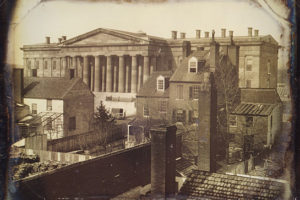 At noon on Thursday, May 2, 1861, President Abraham Lincoln raised the flag over the Patent Office at 7th and F streets, NW, Washington, DC. The patent office was a familiar place for Lincoln. Today it is the National Portrait Gallery (including a portrait of Lincoln and the other presidents) and the Smithsonian American Art Museum (featuring many Civil War paintings). It was also where Lincoln’s own patent for “an improved method of getting vessels over shoals” was located (now in Smithsonian’s vault).
At noon on Thursday, May 2, 1861, President Abraham Lincoln raised the flag over the Patent Office at 7th and F streets, NW, Washington, DC. The patent office was a familiar place for Lincoln. Today it is the National Portrait Gallery (including a portrait of Lincoln and the other presidents) and the Smithsonian American Art Museum (featuring many Civil War paintings). It was also where Lincoln’s own patent for “an improved method of getting vessels over shoals” was located (now in Smithsonian’s vault).
Lincoln would use the patent office four years later for an inaugural ball. Cleared of its displays of patent models, the great hall had become a military barracks, army hospital, and morgue during the Civil War. The hope was that it would once again become a place of the future. Lincoln himself had regaled the benefits of the patent system in his “Discoveries and Inventions” lecture, in which he described how the patent system “added the fuel of interest to the fire of genius, in the discovery and production of new and useful things.” And indeed, it did. During the Civil War, more than 30,000 patents were issued by the United States government; the Confederacy issued only 266. Lincoln’s foresight – and that of the northern states – helped position the United States for victory over the Confederate insurrection. It also helped modernize the United States, which I discuss more in my book, Lincoln: The Fire of Genius.
From that book:
“Be it known that I, Abraham Lincoln, of Springfield, in the county of Sangamon, in the state of Illinois, have invented a new and improved manner of combining adjustable buoyant air chambers with a steam boat or other vessel for the purpose of enabling their draught of water to be readily lessened to enable them to pass over bars, or through shallow water, without discharging their cargoes; and I do hereby declare the following to be a full, clear, and exact description thereof, reference being made to the accompanying drawings making a part of this specification.”
His astounding grasp of both the necessary physics and the intricacy of the design is demonstrated in three accompanying figures – a side elevation, a transverse section, and a longitudinal vertical section – that show the placement of the buoyant chambers on the sides of the vessel.
On April 13th, Robbins wrote excitedly to Lincoln: “It affords me great pleasure to inform you that I have obtained a favorable decision on your application…The patent will be issued in about a month.” On May 22nd, Abraham Lincoln received Patent Number 6469 from the U.S. Patent Office, the only president ever to receive a patent. A few weeks later, Lincoln recommended his model creator Walter Davis be appointed Receiver of the Land Office in Springfield.
There is much more in the book, of course, including Smithsonian Secretary Joseph Henry’s family connection to the patent office, as well as its connection to the new Department of Agriculture created by, you guessed it, Abraham Lincoln.
More on The Fire of Genius.
 The book is available for pre-order on the Rowman & Littlefield website (Lyons Press is a trade imprint of Rowman). You can also pre-order it on Amazon and Barnes and Noble (click on the respective links to pre-order). Release date is scheduled for September 1, 2022.
The book is available for pre-order on the Rowman & Littlefield website (Lyons Press is a trade imprint of Rowman). You can also pre-order it on Amazon and Barnes and Noble (click on the respective links to pre-order). Release date is scheduled for September 1, 2022.
The book is also listed on Goodreads, the database where I keep track of my reading. Click on the “Want to Read” button to put it on your reading list. That will also ensure you get informed of the release date AND will let you try for one of ten free hardcover copies of the book that I’ll be giving away this summer. I’ll also be giving away as many as a hundred e-books. [The book will also be put out on audio]
You also follow my author page on Facebook.
I’ll have much more about the book over the next few months, so join my mailing list here to keep informed.
David J. Kent is President of the Lincoln Group of DC and the author of Lincoln: The Man Who Saved America. His previous books include Tesla: The Wizard of Electricity and Edison: The Inventor of the Modern World and two specialty e-books: Nikola Tesla: Renewable Energy Ahead of Its Time and Abraham Lincoln and Nikola Tesla: Connected by Fate.
[Photo source: https://www.uspto.gov/learning-and-resources/newsletter/inventors-eye/putting-down-roots-patent-office]



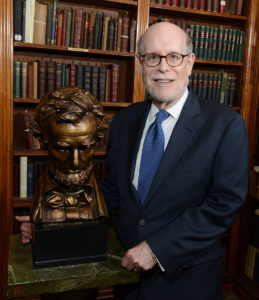 One part of the process of putting together a book is asking prominent experts in the field to read an advance copy and provide back cover “blurbs.” I am very happy to report that one of the most highly respected and prolific leaders on Abraham Lincoln – Harold Holzer – has offered the following praise for
One part of the process of putting together a book is asking prominent experts in the field to read an advance copy and provide back cover “blurbs.” I am very happy to report that one of the most highly respected and prolific leaders on Abraham Lincoln – Harold Holzer – has offered the following praise for 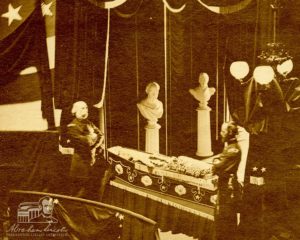 Abraham Lincoln died at 7:22 am on the morning of April 15, 1865. The final chapter in Lincoln: The Fire of Genius is called “Assassination Science.” It starts this way:
Abraham Lincoln died at 7:22 am on the morning of April 15, 1865. The final chapter in Lincoln: The Fire of Genius is called “Assassination Science.” It starts this way: I will be giving a presentation on April 13, 2022, titled “
I will be giving a presentation on April 13, 2022, titled “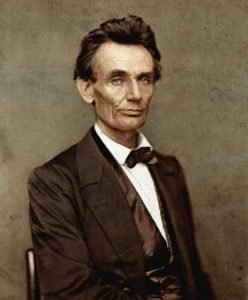 Abraham Lincoln once advised in the prosecution of Isaac Wyant, who had his arm amputated after being shot in a border dispute with Anson Rusk. Following his recovery, Wyant sought out and shot Rusk four times, then pleaded not guilty by reason of temporary insanity. Lincoln’s old friend Leonard Swett was on the side of the defense.
Abraham Lincoln once advised in the prosecution of Isaac Wyant, who had his arm amputated after being shot in a border dispute with Anson Rusk. Following his recovery, Wyant sought out and shot Rusk four times, then pleaded not guilty by reason of temporary insanity. Lincoln’s old friend Leonard Swett was on the side of the defense.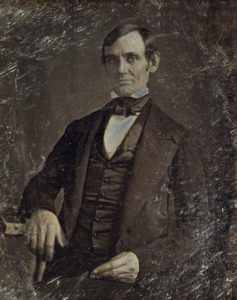 On March 23, 1860, one of Lincoln’s more famous cases came to trial in the U.S. District Court. Johnston v. Jones & Marsh, more commonly known as the Sand Bar case, was important both because of its subject matter (it highlighted Lincoln’s experience with technology) and because, in an age where trial transcripts were almost never kept, journalist Robert Hitt was paid to sit through the entire trial and create a comprehensive 482-page trial transcript, although he omitted the closing arguments.
On March 23, 1860, one of Lincoln’s more famous cases came to trial in the U.S. District Court. Johnston v. Jones & Marsh, more commonly known as the Sand Bar case, was important both because of its subject matter (it highlighted Lincoln’s experience with technology) and because, in an age where trial transcripts were almost never kept, journalist Robert Hitt was paid to sit through the entire trial and create a comprehensive 482-page trial transcript, although he omitted the closing arguments.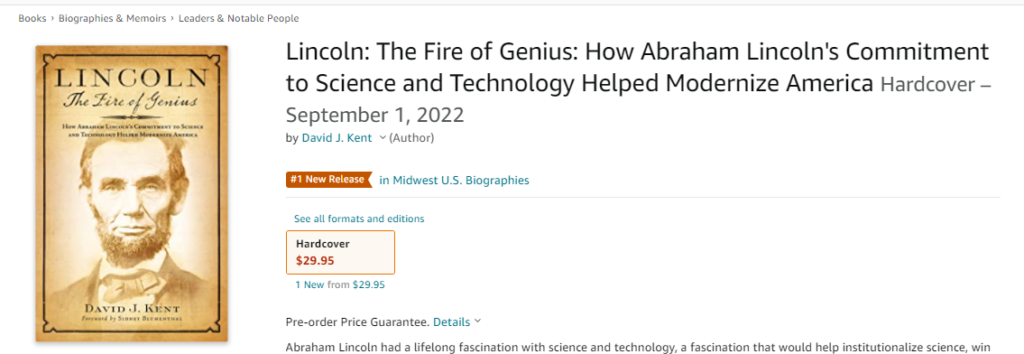
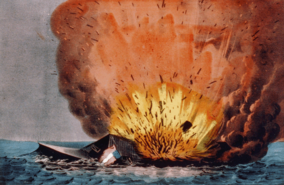 Abraham Lincoln spent much of his day on March 9, 1862 fretting over the battle of the ironclads. The Union ironclad Monitor had fought to a draw with the Confederate ironclad Virginia (former the USS Merrimack) at Hampton Roads, Virginia. The Virginia had been created from the burnt out hull of the Merrimack, left behind at Gosport Navy Yard at the beginning of the war after the state of Virginia seceded. The Merrimack was converted by the Confederate Navy into a seemingly indestructible metallic monster soon to prey on Union ships. Even though the ship was now officially the Virginia, the alliteration of Monitor and Merrimack (and the end of the Confederacy) means most people refer to the ship by its former name, both then and now.*
Abraham Lincoln spent much of his day on March 9, 1862 fretting over the battle of the ironclads. The Union ironclad Monitor had fought to a draw with the Confederate ironclad Virginia (former the USS Merrimack) at Hampton Roads, Virginia. The Virginia had been created from the burnt out hull of the Merrimack, left behind at Gosport Navy Yard at the beginning of the war after the state of Virginia seceded. The Merrimack was converted by the Confederate Navy into a seemingly indestructible metallic monster soon to prey on Union ships. Even though the ship was now officially the Virginia, the alliteration of Monitor and Merrimack (and the end of the Confederacy) means most people refer to the ship by its former name, both then and now.*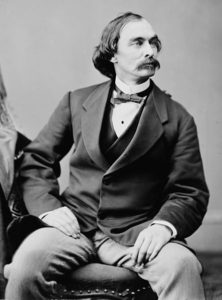 Abraham Lincoln had a knack for meeting Arctic explorers. On March 1, 1862, Lincoln wrote to Secretary of War Edwin Stanton:
Abraham Lincoln had a knack for meeting Arctic explorers. On March 1, 1862, Lincoln wrote to Secretary of War Edwin Stanton: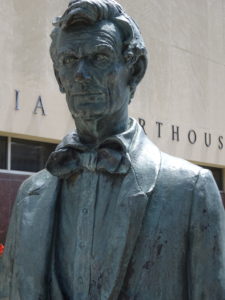 Abraham Lincoln accused Russia of being a place “where despotism can be taken pure,” openly dedicated to the exercise of absolute power and cruelly oppressive.
Abraham Lincoln accused Russia of being a place “where despotism can be taken pure,” openly dedicated to the exercise of absolute power and cruelly oppressive.






